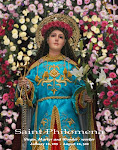In a meeting of the Parish Pastoral Team, I was informed of the pilgrimage of the Cross of the Sierra Madre mountains. This pilgrimage is aimed at raising awareness regarding the devastation of the Sierra Madre on account of logging and mining operations. Obviously, this is an ecological pilgrimage - something that is in fashion today.
I looked into the pamphlet and I saw a creative liturgical rite which disturbed me:
Misa Alay sa Sierra Madre at sa Buong Sangkalikasan
(Mass offered to the Sierra Madre and to all Creation)
Maaring gamitin ang Liturhiyang ito sa pagdiriwang. O kaya di man ay maari rin namang pumili ng ilang bahagi nito na pwedeng gamitin sa Misa.
(This rite may be used for the celebration. Or if not, some parts of this may be chosen for Mass)
I. PAGBATI AT PAGPUPUGAY SA ESPIRITU NG KALIKASAN
Greeting and Salutation to the Spirit of Nature
(Maaring gawin ito sa labas ng simbahan - ang bawat isa ay may hawak na kandila)
(This may be done outside the church - each person holds a candle)
Obispo/Pari: Batiin natin ang bawat isa at ang lahat ng bahagi ng Sangkalikasan ng isang umagang puspos ng pagpapala ng Diyos na Maylikha. (Bigyan puwang ang pagbabatian) Atin ngayong sindihan ang ating mga kandila at bigyang pugay ang Espiritung nagbibigay at nagpapadaloy ng buhay.
Let us greet one another and the whole of Creation with a morning filled with blessings from the Creator God. (Give room for the greetings) Let us now light our candles and honor the Spirit who gives life.
Panalangin sa Apat na Direksyon
Prayer to the four Directions
Tagapamuno: Batiin natin ang dakong Silangan na siyang nagdadala ng liwanag ng Araw (Itataas ang malaking kandila) Amang Araw, sa 'yong nakabubulag na kasikatan, bigyan kami ng lakas, liwanag, at kaalaman.
Let us greet the East which bring the light of the Sun. (The big candle is raised) Father Sun, in your blinding radiance, give us strength, light, at knowledge.
Lahat: Espiritu ng Apoy, kami sa yo'y nagpupugay.
Spirit of Fire, we salute / honor you.
Tagapamuno: Batiin natin ang dakong Hilaga na siyang nag-aalaga ng mga bahaging lupa (Itaas ang sisidlang may lupa o isang maliit na punong kahoy) Inang Lupa na nagkakalinga ng buhay ng Santinakpan, bigyan kami ng lakas na lumagong kapakipakinabang.
Let us greet the North which cares for the earth (A container of soil or a small plant is raised.) Mother Earth that cares for the life of all Creation, give us strength to grow usefully.
Lahat: Espiritu ng Lupa, kami'y sa yo'y nagpupugay.
Spirit of Earth, we salute / honor you.
Tagapamuno: Batiin natin ang dakong Kanluran na siyang nagpapadaloy ng tubig na nagbibigay buhay (Itaas ang sisidlang may tubig) Inang Karagatan at Tubig-Kanlungan, ikaw ang pumapatid ng aming uhay, gawin mo kaming daan ng kalinisan at kagalingan.
Let us greet the West which makes the life-giving waters flow. (A container of water is raised.) Mother Seas and Bosoms of Water, you quench our thirst, grant that we may be means for purity and wellness.
Lahat: Espiritu ng Tubig, kami sa yo'y nagpupugay.
Spirit of Water, we salute / honor you.
Tagapamuno: Batiin natin ang dakong Katimugan na nagbibigay daan sa hininga ng buhay (Itataas at patutunugin ang chimes) Amang Kalawakan, hanging may kaginhawaan, bigyan kami ng lakas na magsaya at magdiwang.
Let us greet the South which gives way to the breath of life (The chimes are raised and made to sound) Father Space, air that comforts, give us the strength to rejoice and celebrate.
Lahat: Espiritu ng Hangin, kami sa yo'y nagpupugay.
Spirit of the Air, we salute / honor you.
Obispo/Pari: Sa ating pagsasama-sama, ang Banal na Espiritu, ang Enerhiya ng Diyos na nagbibigay-buhay ay sumasaatin. Kasama ang buong Sangkalikasan, tayo ngayon ay magpuri sa kanya at ipaabot ang ating pagkamangha at paghanga sa kanyang Pangalan.
In our gathering, the Holy Spirit, the Life-giving Energy of God is with us. Together with all creation, let us praise him and express our awe and admiration for his Name.
______________________________________________________________
While claiming to praise the Holy Spirit (the Energy of God?), the prayers actually honor the spirits of nature which we call the "elementals" or nature spirits (which are actually demonic spirits worshiped by animists.
I remember the first reading for Monday of the 12th Week in Ordinary Time:
"This (the Assyrian Occupation) came about because the children of Israel sinned against the Lord...and because they venerated other gods. They followed the rites of the nations..." (2 Kings 17: 7-8)
The Smoke of Satan entering the cracks of the Church?
































